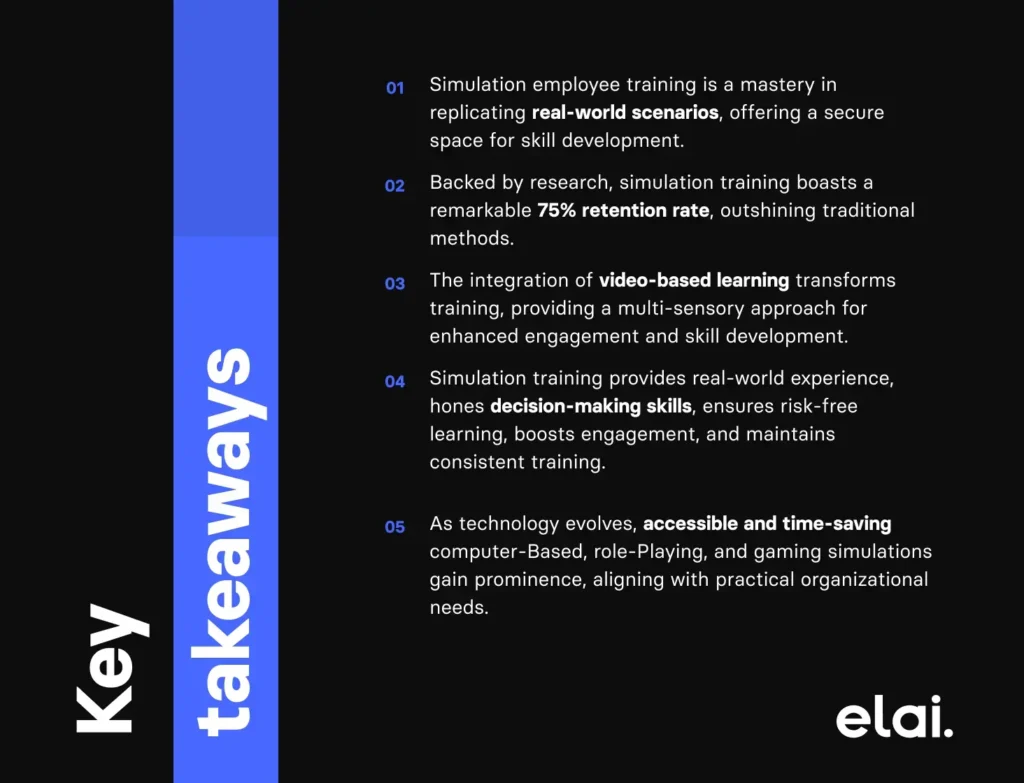Simulation employee training meaning contains a pivotal methodology, skillfully replicating real-life scenarios within a controlled environment. This immersive approach allows participants to engage in activities mirroring their work environment, fostering a secure, risk-free space for honing skills. Bolstered by research, simulation training boasts an impressive 75% retention rate, outshining traditional methods that typically hover between 5-10% (National Training Laboratory).
As we delve deeper into the evolution of training methodologies, integrating video-based learning into simulation training emerges as a transformative step. This union of simulation and video-based elements amplifies the learning experience, offering a multi-sensory approach that enhances engagement and skill development.
Key Takeaways:
- Simulation employee training is a mastery in replicating real-world scenarios, offering a secure space for skill development.
- Backed by research, simulation training boasts a remarkable 75% retention rate, outshining traditional methods.
- The integration of video-based learning transforms training, providing a multi-sensory approach for enhanced engagement and skill development.
- Simulation training provides real-world experience, hones decision-making skills, ensures risk-free learning, boosts engagement, and maintains consistent training.
- As technology evolves, accessible and time-saving Computer-Based, Role-Playing, and Gaming Simulations gain prominence, aligning with practical organizational needs.

Benefits of Simulation Training in Employee Development:
Real-world Experience: Simulation training provides a realistic setting for employees to apply their knowledge and skills, preparing them for on-the-job challenges.
Decision-Making Skills: Participants learn to make critical decisions under pressure, enhancing problem-solving abilities in a controlled environment.
Risk-Free Learning: Simulations create a safe space for employees to make mistakes, learn from them, and improve without real-world consequences.
Enhanced Engagement: Interactive simulations capture employees’ attention, boosting engagement by immersing them in the learning process.
Consistent Training: Simulation ensures that all employees receive a uniform training experience, regardless of their location or role.
Simulation Employee Training Advantages and Disadvantages
Advantages:
- Practical Skill Development
- Risk-Free Learning
- Customization for Specific Industries
- Enhanced Retention
- Immediate Feedback
Disadvantages:
- Initial Cost and Setup
- Time-Consuming Development
- Lack of Emotional Realism
- Technology Dependency
- Difficulty in Simulating Every Scenario

Types of Simulation Training
Virtual Reality (VR) Simulations: Utilizing computer-generated environments, VR simulations immerse participants in lifelike scenarios, enhancing situational awareness and practical skills.
Augmented Reality (AR) Simulations: Integrating digital information into the real-world environment, AR simulations provide overlays of data or visuals, enriching training experiences.
Computer-Based Simulations: These simulations run on computers and often involve interactive scenarios, offering a cost-effective and accessible alternative for a wide range of industries.
Role-Playing Simulations: Involving interpersonal interactions, role-playing simulations allow participants to practice communication and decision-making skills in a controlled setting.
Gaming Simulations: Incorporating game-like elements, these simulations add an element of competition and fun, enhancing engagement and motivation.
While Virtual Reality (VR) and Augmented Reality (AR) in Corporate Training are impactful, their high costs limit widespread implementation. This makes Computer-Based, Role-Playing, and Gaming Simulations more accessible and time-saving, aligning with the practical needs of many organizations.
The digital era has seamlessly facilitated the transition of training to simulation employee training online platforms, allowing employees to access training materials remotely and fostering flexibility and accessibility.
Integration of Video-Based Learning in Simulation
Simulation training immerses participants in lifelike scenarios, and the addition of video-based elements amplifies this experience, bringing a visual dimension to the learning process.
Video-Based Training Simulation Examples
Virtual Demonstrations: Video demonstrations within simulations offer a visual guide, illustrating correct procedures and techniques.
Scenario Narration: Integrating videos to set the context for simulated scenarios enhances realism and engages participants emotionally.
Expert Insights: Video interviews with industry experts offer valuable perspectives, enriching the learning experience with real-world insights.
Elai.io - AI Avatar Video Tool for L&D
In this era of advanced learning technologies, integrating AI avatar video tools like Elai.io can elevate the effectiveness of simulation and video-based training. Elai.io allows organizations to create engaging and personalized learning experiences by generating lifelike avatars that deliver training content in a dynamic and interactive manner. This tool adds a human touch to virtual scenarios, enhancing realism and connection in the learning process.
Simulations Employee Training Examples
Flight Simulators for Pilots
Replicating cockpit environments and flight simulators enables pilots to practice procedures, emergency scenarios, and navigation in a realistic setting. It enhances decision-making skills and prepares pilots for various challenges without real-world risks.
Medical Simulations for Healthcare Professionals
Medical simulations recreate clinical scenarios, allowing healthcare professionals to practice surgeries, patient care, and critical decision-making. These simulations provide a safe space for refining skills before fundamental patient interactions.
Business Strategy Simulations
Business strategy simulations immerse participants in simulated business environments to make strategic decisions, manage resources, and understand market dynamics. Valuable for honing strategic thinking in a risk-free setting.
Emergency Response Simulations for First Responders
Emergency response simulations replicate crisis situations, enabling first responders to practice coordination, communication, and decision-making during disasters. Essential training for effective emergency response.
Customer Service Simulations
Simulating customer interactions, these scenarios help service representatives practice communication, problem-solving, and conflict resolution. Ensures customer service teams are well-prepared for real-world situations.
In conclusion, simulation training represents a powerful force in unlocking the potential of employee development. From realistic experiences and practical skill development to enhanced engagement and multi-sensory learning, this methodology paves the way for a future where learning is immersive, compelling, and tailored to individual needs.
FAQ
What is simulation employee training?
Simulation employee training is a learning methodology replicating real-world scenarios in a controlled environment, providing a safe space for employees to practice and refine their skills.
What are the benefits of simulation training in employee development?
The benefits include real-world experience, enhanced decision-making skills, risk-free learning, increased engagement, and consistent training.
What is simulation-based training?
Simulation-based training involves the use of simulated scenarios or environments to facilitate experiential learning and skill development.
What is simulation exercise in training?
A simulation exercise in training refers to a practical activity that mimics real-world situations, allowing participants to apply their knowledge and skills in a controlled setting.


